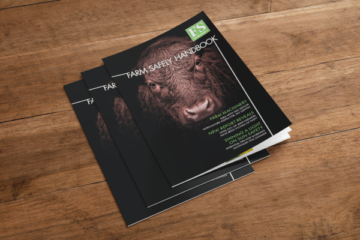A day in the life of a dairy farmer is a tough one, with no two days the same. While difficult at times, being a dairy farmer is also rewarding and exciting. A passion for the land, animals and safety is a must.
The Farm Safely Handbook talks to Robert McConnell, a 31-year-old dairy farmer working on a farm located in Loganstown Co Meath. Robert gives us an insight into his daily life on the farm, his dreams for the future, and some of the safety measures he practices so that everyone on the farm is safe.
Farm Safely Handbook: Can you tell us a little bit about your background and how you got into the farming business?
Robert McConnell: I’ve always been on the farm and was involved in the farm from a young age. After college, I decided to get my Green Cert. When the opportunity came, I decided to form a partnership with my parents, and that’s kind of how I got into it. It’s a family farm.
FSH: Can you describe and take us through a day in the life of a dairy farmer?
RM: Well, like any farm in Ireland, it’s really seasonal based, and you can bet that it’s usually an early start. I would start work at around six in the morning and I try to finish work at half six in the evening, but it can go on longer sometimes. It depends on the time of the year, during spring is our heaviest workload, so there’d be long days then.
Every day I wake up, do the milking, feed the animals, and do grass management. I have a spring herd now, so the herd is kind of winding back now at the minute. We have gone back to once-a-day milking, so I can finish when it gets dark now.
FSH: What would you say are the highlights of your job?
RM: I really enjoy working with the animals, and I really enjoy just being outside for a lot of the day. Also, the challenges that come with farming can be fun, and keep you on your toes.
No two days are the same, you would think it’s repetitive but because it’s so seasonal, it’s never too repetitive for too long.
FSH: In your opinion, what are some of the difficulties or challenges that a dairy farmer faces throughout the year?
RM: The biggest challenge that dairy farmers would face is mainly the weather. So you’re constantly making decisions on what the weather is giving you throughout the year.
Another difficulty would be the heavy workload, it can be hard to manage sometimes in the peak parts of the year, like in the springtime, it can be a bit challenging. Also, work-life balance can be challenging just to get it right and have a nice rhythm with it.
FSH: What do you think are the key safety points that young farmers should know when they are starting out, for example, safety tips for working in the parlour/or with machinery?
RM: In general, it’s important to be mindful when you’re working with cattle. It takes half a second to get into a bad spot with an animal, so you always have to have an exit when you’re working in enclosed sheds during the winter or anything like that.
Nowadays, it’s great because you can learn a lot from the internet, there are so many tutorials on YouTube. So it’s not like it used to be when you had to learn from who you saw it from. It’s a lot better now because there is so much information available.
The most dangerous time when working with cattle is in the spring when you are most likely in the sheds, you’re calving a lot of animals, and you’re in enclosed spaces. So that can be a tricky time.
FSH: Do you have any safety tips on how to get to know the behaviours of animals and how they would react in certain situations?
RM: When a cow freshly calves, then she could be the friendliest cow going, but if you just come into the pin in the wrong way, she can feel a bit trapped, and she’ll stand-off to you. You have to just always think that a cow will do that because like I said she could be the friendliest cow, but she could always just turn on you, so you have to always be cautious and have that in mind.
FSH: Has there been any new technology in recent years that has helped you do your job more efficiently? And if so, what is it?
RM: Things that have helped me out in the last few years, were that I installed three or four calving cameras. It just makes it so much easier that you can be at home, and you can keep an eye on what’s going on in the shed. It takes a lot of work out of it during the calving season.
FSH: What are some of your short and long-term goals for the farm?
RM: We’re currently doing up our milking parlour, so we are extending it and just making it a bit more modern. So my short-term plan would be just to get it done before we start calving in February. We are increasing its capacity, so it was a ten-a-side milking parlour, and we are increasing it to a 20-a-side. It will have cluster removers, auto ID, milk indicators, and milk sample points. We are streamlining it and it will make our jobs a lot easier.
My long-term goals are to improve grass management and update calving facilities, and just generally try to make the place a better place to work.
FSH: What safety measures do you take to ensure that everyone stays safe on the farm?
RM: What I would do is, I would have plenty of warning signs up for different things, so if you have an entrance from a house to a farm you should have hazard signs up.
Also, if there are any visitors on the farm, it’s important to accompany them, and let them know that they should be accompanied if they’re going to be out on the farm.
If there are multiple people working on the farm, it’s also important to let everybody know what everyone else is doing, so that there’s no confusion or people crossing over each other.
For electricity, all of our fuse boards are kept away and locked up, and we have hazard signs for electricity posts so that you’re aware of them when you’re going under them with equipment.
FSH: What did you learn from your time working on the farm so far?
RM: I’ve learned a lot about animal nutrition, and it’s a pretty key point to just getting everything right. Once you have it right, a lot of other things fall into place.



